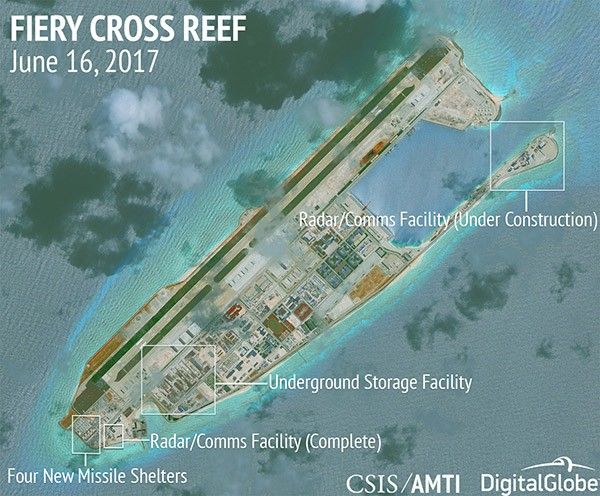Can China defend South China Sea island bases?


CHINA has established military bases on islands built up in the South China Sea, including the Philippines’ exclusive economic zone, but can Beijing defend them in an armed conflict?
The question was posed by defense and security analyst Robert Farley in his article that appeared Feb. 19 in The National Interest, an American bimonthly international affairs publication.
Farley’s answer to the question, as gleaned from his article reprinted in the warisboring.com website, sounds like a qualified “Maybe, but…”
He recalled that during World War II, Japan found that control of islands offered some strategic advantages, but not enough to force the United States to reduce each island individually. Moreover, over time the islands became a strategic liability, as Japan struggled to keep them supplied with food, fuel and equipment.
The South China Sea islands are conveniently located for Beijing, but do they represent an asset to its military? Farley’s answer is “Yes,” but added that in an actual conflict their value would dwindle quickly. Excerpts from his article:
“China has established numerous military installations in the South China Sea, primarily in the Spratly and Paracel Islands. In the Spratlys, China has built airfields at Subi, Mischief and Fiery Cross, along with potential missile, radar and helicopter infrastructure at several smaller formations. In the Paracels, China has established a significant military installation at Woody Island, as well as radar and helicopter facilities in several other areas.
“China continues construction across the region, meaning that it may expand its military presence in the future. (Philippines, take note. – fdp)
“The larger bases – Subi, Mischief, Fiery Cross and Woody Island – have infrastructure for the management of military aircraft, including fighters and large patrol craft. These missiles, radars and aircraft extend the lethal reach of China’s military across the breadth of the SCS.
“Several of the islands serve as bases for SAM systems – including the HQ-9, with a range of 125 miles, and perhaps eventually the Russian S-400 – and ground-launched cruise missiles, or GLCMs. These missiles serve to make the South China Sea lethal for US ships and aircraft that do not have stealth capabilities, or that do not enjoy a layered air-defense system.
“The SAM installations, buoyed by networks of radars, can effectively limit the ability of enemy aircraft to enter their lethal zone without significant electronic-warfare assistance. The GLCMs can add another set of launchers to China’s A2/AD network, although not necessarily with any greater effectiveness than missiles launched from subs, ships or aircraft.”
• Duterte rules out Chinese aggression
IT IS an open question, Farley said, how survivable China’s missile installations on the artificial islands would be in an armed conflict.
What conflict? President Rodrigo Duterte may interpose. He has given assurance that China’s forward bases in Philippine waters (squatting there in violation of the Constitution) will not be used against the host country.
Confident of his tight hold on this nation of some 105 million and the alleged “good faith” of his Chinese counterpart Xi Jinping (now on his way to a no-expiry presidency), Duterte has unilaterally exempted China from the constitutional ban on foreign bases.
Nobody in the Senate, whose advice and concurrence are needed by the President in forging treaties and international agreements, has found the courage to question Duterte’s ignoring of the chamber’s role in foreign relations.
Even if the constitutional question were raised before the Supreme Court – whose Chief Justice is being roasted over the impeachment coals by Duterte’s supermajority in the House of Representatives – the tribunal is not likely to rule against the Chinese bases.
Constitutional “niceties” will not stand in the way of a determined autocrat or in a situation where co-equal branches of government have been effectively cowed or co-opted. More so if such non-government watchdogs as the media have been compromised or intimidated.
Challenge can be expected from outside, such as from the US, Japan and Australia when the operation of the Chinese bases disturbs or impedes the normal traffic in the South China Sea where $5.3 trillion worth of goods pass annually.
While none of the user-nations affected by a constriction of the SCS wants war, military action is always an option or a possibility. China’s island bases will be in the middle of any fray.
• Defending island bases difficult
FARLEY noted: “China’s islands in the SCS are not mobile, and are not large enough to hide much in the way of military equipment and materiel. The US will be able to map the installations on each of the islands, and will probably be able to track shipments to them.
“This will make the islands extremely vulnerable to attack from ships, subs and aircraft, as missiles will not require real-time targeting data.
“Land-based missiles survive air attack because they can hide among hills, forests and other natural cover. There is no effective natural cover on the islands that China has created, and even man-made defensive installations may not survive concerted attack.
“Moreover, missile launchers depend upon an at least somewhat robust logistical network for fuel, power and munitions, which China may not be able to reliably provide during a shooting war.
“The four largest military installations in the SCS have extensive facilities for the operation of military aircraft. This includes advanced fighters, but more importantly patrol, electronic-warfare and advanced early-warning aircraft.
“The ability to use these airfields effectively extends the reach of China’s A2/AD bubble, enabling the transmission of targeting data to missile launchers at sea and in mainland China. The fighter aircraft themselves serve to make the skies over the SCS even more lethal than they otherwise would be, as well as threaten US ships at a distance with cruise missiles.”
* * *
ADVISORY: All Postscripts can be accessed at manilamail.com. Follow author on Twitter as @FDPascual. Email feedback to [email protected]
- Latest
- Trending




























